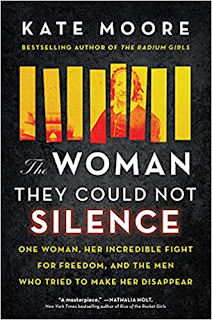The Woman They Could Not Silence
It's hard to say anything about this book besides --- wowzers, this is a fantastic, amazing story, and everyone should read it. Including you.
This is the life story of Elizabeth Packard, a completely ordinary woman, wife, and mother of six in Illinois. In 1860, as the United States was headed towards war, Elizabeth and her husband were in disagreement about religion. Theophilus was a Presbyterian minister, and while Elizabeth had been joyfully discovering new ideas about women's rights, he was under pressure to guide his congregation into a stricter, more conservative theology (which, among other things, was neutral about slavery, in contrast to the church's previous anti-slavery position). Elizabeth's insistence on her right to read widely, have her own ideas, and argue them in public grated on Theophilus, and he determined to do something about it.
"I, though a woman, have just as good a right to my opinion, as my husband has to his...I have got a mind of my own, and a will too, and I will think and act as I please."
At this time, a married woman had no legal existence; her property and her person belonged to her husband absolutely. She had no rights except those he chose to grant her. And a husband could commit his wife to an insane asylum with no particular trouble. All he had to do was find a doctor willing to take his word -- and most doctors were. Elizabeth was seized and put into the Illinois State Hospital at Jacksonville, run by Dr. Andrew McFarland. He was a popular man, and the hospital trustees took his word for it that the hospital was run along the best lines. If the inmates complained, well, who would take the word of an insane person?
Elizabeth discovered quite a population of perfectly sane women who had been incarcerated by their husbands. She made close friends and started a practice of prayer meetings, and when she complained of their treatment to Dr. McFarland, she was punished. Removed to a ward of women who actually did suffer from mental illness, she tried her best to care for them and fight the neglect and abuse they suffered. Her pleas for bathtubs, so the women could be clean, backfired horribly when the tubs were used as cold-water punishments. Over time, though, Elizabeth managed to make allies among the asylum employees, some of whom were willing to testify to what they knew. She also wrote down what she saw and heard from her friends.
The story of how Elizabeth fought tirelessly for reform in mental asylums is a difficult one, and a testament to her incredible strength, intelligence, and persistence. It is absolutely gripping, and an important book to read, I think.
Moore also provides a well-calculated amount of background context -- she doesn't explain everything into the ground, but does let us know that in 1860, any disorder in the dress, grooming, or behavior of a woman was an easy way to be harshly judged. Elizabeth could not afford to fight the men who took her prisoner. She could not shout to the watching crowd, scream for her children, or lose her composure in any way, because it would only be taken as proof of her insanity. At the asylum, women were not given facilities to be clean or well-dressed, but their lack of cleanliness was proof that they belonged in an asylum.
Elizabeth Packard dedicated her life to giving voice to the people suffering under this system, and she was an instrumental power in changing it. I think this will be one of my favorite books of the year, and I hope others will read it too.





Your recommendation is good enough for me!
ReplyDelete